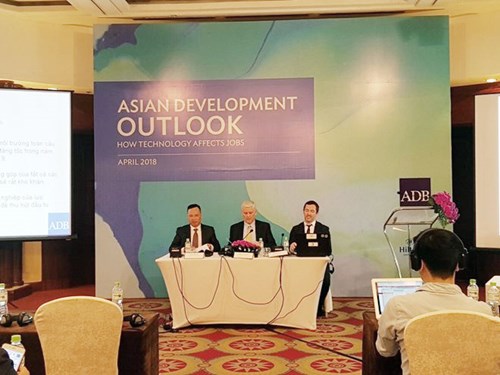“Aided by able macroeconomic management, economic growth will spurt in 2018, with Vietnam becoming one of the strongest performers in the region”, said ADB Country Director for Vietnam Eric Sidgwick.
    |
 |
|
At the press conference to launch the ADB new report on April 11 |
Vietnam’s robust economic growth will be driven by vigorous manufacturing and export expansion, rising domestic consumption, strong investment fuelled by foreign direct investment (FDI) and domestic enterprises, and an improving agriculture sector, he added.
Vietnam has been able to mobilise an abundant supply of young, well educated workers to attract foreign investment to labour-intensive manufacturing over the last decade. However, as the Vietnamese economy becomes more sophisticated, the gap between worker qualifications and business needs is widening, Sidgwick warned, noting that if not addressed, this skills gap could become a major obstacle to Vietnam’s development aspirations.
The ADB report showed that robust private consumption is expected to be supported by rising incomes and stable inflation and prospects for private investment are bright.
By sector, solid FDI should enable the industrial sector to maintain strong growth momentum. Construction is projected to pick up in 2018 and 2019, benefitting from last year’s record FDI commitments and disbursements.
Meanwhile, the service sector is projected to sustain growth in 2018 and 2019, with tourist arrivals forecast to rise by 15-20 percent this year and bank lending to grow by 17-18 percent. Agriculture is expected to continue to pick up over the next two years, growing in 2018 broadly in line with the government target of 2.8-3.0 percent.
Inflation is projected to edge up but remain broadly stable, averaging 3.7 percent this year and rising to 4.0 percent in 2019 as strong domestic demand and high bank lending are partly offset by stable domestic food and transportation costs, along with smaller increases in administered prices for education, health care, electricity and water.
The current account surplus is projected to narrow to 2.5 percent of GDP this year and 2.0 percent in 2019. Merchandise exports are forecast to rise by 15-20 percent in 2018 and 2019. Remittances are likely to remain strong thanks to improving global prospects and a stable exchange rate.
Pointing out challenges to Vietnam’s economic growth, the report noted that the country has an abundance of efficient labour working for relatively low wages. This attracts large FDI inflows especially for labour-intensive export-oriented manufacturing. Since 2012, manufacturing has absorbed on average 400,000 workers per year. However, a skills gap is emerging as an obstacle to FDI absorption and to business more generally.
To address this skills gap, Vietnam needs to prioritise three sets of initiatives toward strengthening its universities as well as technical and vocational education and training (TVET) system: expanding access, improving quality, and streamlining governance.
Source: VNA